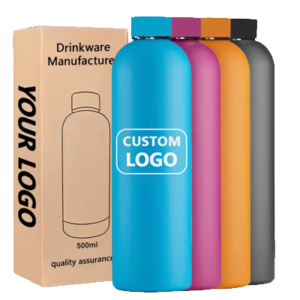Can a Stainless Steel Tumbler Feel Like Ceramic?
Quick answer: Absolutely, yes.
With the right surface treatment, a stainless steel tumbler can totally pull off a ceramic “disguise” — both in appearance and texture.
When manufacturing water bottles, we usually achieve this effect through a coating process called baking paint (also known as baking varnish). Think of it as giving the tumbler a carefully applied “makeup look”: the glossy (or matte!), silky-smooth finish makes it look and feel just like a ceramic mug — while secretly keeping all the benefits of stainless steel underneath.
Want it to look like porcelain? No problem. Prefer a frosted handmade pottery vibe? Also doable. The magic lies in the paint formula and curing technique during production — that’s how a metal cup ends up fooling your fingertips into thinking it’s ceramic.
Table of Contents
ToggleWhat Is “Baking Varnish”?
Baking varnish is a surface-finishing process in which a liquid coating is sprayed onto a cup body and then cured at high temperature, forming a solid, continuous paint film. The key mechanism lies in the chemical cross-linking reaction of resins (and other ingredients) in the coating when exposed to heat, which causes the coating to change from liquid to solid and strongly adhere to the cup surface.
The process begins with selecting a suitable coating based on the product material and desired finish — common choices include polyester baking paint and epoxy baking paint. Next, the coating is evenly sprayed onto the surface to form a smooth, thin layer. Finally, the sprayed cup body is placed into an oven (typically at 120 ℃ to 200 ℃), where it is baked for a set time so that the molecular structure of the coating transforms into a hard, smooth film with good wear and corrosion resistance.
We generally divide baking paint into two categories based on curing temperature:
1. Low-Temperature Baking Paint
Curing temperature: 60 ℃ – 120 ℃
Low-temperature baking paint cures more slowly, requiring longer oven time and a more free-flowing coating to achieve smooth leveling at lower heat. Although the resulting film is softer, it has excellent flexibility and is less prone to cracking. This makes it ideal for plastic cups, products with complex decorations, and mixed-material designs.
For example:
Plastic water bottles for children — low-temperature baking avoids damaging the plastic while still providing a durable coating.
Cups with many curves and corners — the flexible paint film can withstand stress without peeling or cracking.
2. High-Temperature Baking Paint
Curing temperature: 120 ℃ – 200 ℃
With higher temperatures, the cross-linking reaction happens faster, forming a dense, hard-wearing paint film in a shorter time. The coating must have excellent thermal stability to avoid discoloration or degradation during heating. High-temperature baking paint delivers a harder, more scratch-resistant, and more corrosion-resistant surface, making it perfect for stainless steel tumblers and metal coffee cups that need to withstand daily friction, impacts, and contact with drinks or detergents.
It is also ideal for products requiring rich colors and high-gloss, premium finishes.
Key Differences
| Feature | Low-Temp Baking Paint | High-Temp Baking Paint |
|---|---|---|
| Curing Temp | 60 ℃ – 120 ℃ | 120 ℃ – 200 ℃ |
| Paint Film | Softer, more flexible | Hard, dense, highly durable |
| Best For | Plastics, complex shapes | Metals, high-end durable products |
| Appearance | Matte, frosted, gentle textures | Glossy, mirror-like, saturated colors |
Both types share the same underlying chemistry — using heat to cure liquid coating into a solid film that bonds firmly to the surface — but they serve different material needs and design goals.
What Does Baking Varnish Look and Feel Like?
Low-temperature baking varnish: typically delivers matte or satin finishes with a soft, slightly textured touch — ideal for creating warm, understated styles.
High-temperature baking varnish: forms a glossy, sleek surface similar to a glazed ceramic with a smooth touch and vibrant, even color — perfect for a polished, high-quality aesthetic.

Regardless of type, baking varnish finishes have a seamless, uniform appearance without visible joints or lines, and can perfectly cover curves and irregular shapes to give the cup a consistent, premium look.
Advantages of Baking Varnish Finishing
1. Premium appearance and texture
Both low-temperature and high-temperature baking paint are capable of producing visually impressive finishes. High-temperature baking paint delivers rich color depth and a glossy, almost porcelain-like shine — perfect for high-end, luxury products. Low-temperature baking paint, on the other hand, can be formulated to create matte, satin, or frosted effects, offering designers greater flexibility to achieve different styles and elevate the perceived value of the cup.
2. Protective performance
The hard film formed by high-temperature baking paint provides excellent wear and corrosion resistance, protecting the cup surface from scratches, bumps, watermarks, and mild acids or alkalis during daily use. Though softer, low-temperature baking paint offers strong flexibility, which allows the coating to “move with” the material underneath and resist cracking — particularly useful for plastic cups or products that may deform slightly during use. Both types effectively extend the service life and aesthetic longevity of the product.
3. Colour stability
Paint films formed by baking paint processes exhibit very good colour retention. Even after prolonged exposure to sunlight, temperature changes, or daily washing, the finish is not prone to fading or yellowing — maintaining the original colour vibrancy and gloss over time.
4. Environmental friendliness
In response to increasingly strict environmental regulations, modern baking-paint finishing uses eco-friendly coatings and strictly controls the use and emission of harmful substances in production. These formulas are designed to minimise volatile organic compound (VOC) release during the curing stage. Not only does this help protect the health of production personnel and reduce environmental pollution, it also ensures a safer, more reassuring product for consumers.
What’s the Difference Between Baking Paint and Spray Paint?
1. Process and Principles
Spray paint involves atomising liquid paint through a spray gun using compressed air and coating the cup surface. The coating dries and forms a film through solvent evaporation or chemical reactions at room temperature — usually without a high-temperature curing stage. The process mainly includes surface pre-treatment, paint preparation, spraying, and natural or low-temperature drying. It is simple to operate and requires less specialised equipment.
Baking paint, on the other hand, adds a high-temperature curing stage on top of regular spraying. After the paint is evenly sprayed onto the cup surface, the product is sent into a baking oven where, under controlled temperature and time conditions, the resins in the coating undergo cross-linking reactions to form a firm, dense paint film. Precise temperature control and professional equipment are required to ensure quality.
2. Appearance & Paint Film Performance
Spray paint is highly flexible in achieving artistic or gradient effects thanks to its fast film-forming nature, making it popular for products with hand-painted or more creative design styles. It can produce bright colours and textured finishes that reflect a free, artistic look.
Baking paint is known for its uniform, premium, and highly controllable finish. Whether it is a soft matte texture from low-temperature baking paint or a high-gloss mirror-like finish from high-temperature baking, the resulting colours are full, even, and visually striking — ideal for premium products that emphasise refinement and brand value.
In terms of protection, spray-painted films tend to be softer but have good flexibility — making them less likely to crack when the cup is bumped or slightly deformed. With advances in paint technology, modern spray coatings also offer improved resistance to wear and corrosion and can meet most day-to-day durability needs.
Baking paint, thanks to its high-temperature curing, produces a denser film with higher hardness and excellent abrasion and corrosion resistance. This enables painted cups to maintain their integrity even after long-term exposure to friction and detergents — making the process extremely suitable for insulated tumblers and outdoor drinkware where durability is essential.
3. Cost and Production Efficiency
Spray paint requires minimal upfront investment. Spray guns and basic drying areas are sufficient, and common spray coatings are relatively inexpensive — although multiple passes may be needed to achieve full coverage, increasing coating usage.
Baking paint requires dedicated ovens and temperature-control systems — resulting in higher equipment investment. The coatings used (especially high-temperature types) are typically more expensive, but one pass often gives a high-quality film. In large-scale production, the coating cost per cup may be lower.
As for efficiency, spray paint generally dries quickly — particularly air-drying formulations — allowing fast-turnaround production and rapid customisation. Baking paint requires additional curing time (especially for low-temperature baking), extending the production cycle. However, once production lines are optimised, baking paint remains highly efficient for large-scale, standardised production.
4. Application Scenarios & Product Positioning
Both spray and baking paint are mature and indispensable surface-finishing technologies in the drinkware industry.
Spray paint is well-suited to fast turnaround and creative custom water bottles due to its flexibility and speed. Yep, it’s widely used in personalized cups for gifting and promotional events.
Baking varnish is preferred where long-lasting appearance, durability, and premium positioning are required — e.g. high-end insulated tumblers, executive gift cups, or ceramic-style products. Low-temperature baking paint is also widely used for children’s plastic drinkware to ensure both safety and adhesion strength.
In short, spray paint provides flexibility and speed, while baking varnish brings durability and a high-end aesthetic. Each plays an important role in giving cups both visual appeal and functional value. At Haers, we are highly experienced in both technologies — from process control to quality assurance. Whether you need quick-turn gifting cups or refined, long-lasting finishes, we can tailor the perfect surface-treatment solution for your brand.


